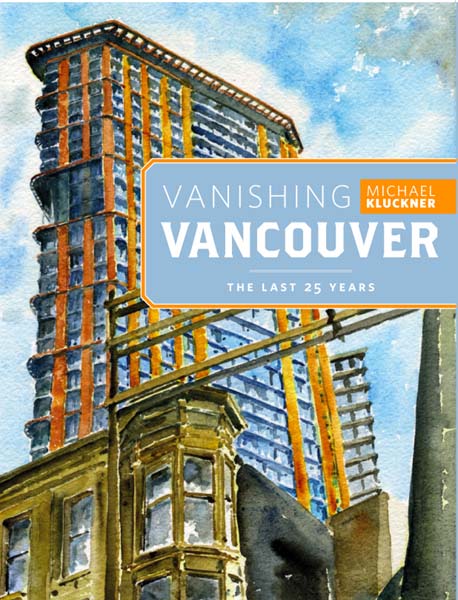I’m amazed by how much change I’ve witnessed in the short time I’ve lived in this city. The Vancouver I know is one of unceding growth, all glass towers and a headlong rush toward the new, new, new. The art deco buildings I remember seeing on visits to the city just 10 years ago are already gone, replaced by mixed-use condos and a Vancouverism that aggressively pushes upwards.
In Vanishing Vancouver: The Last 25 Years, author Michael Kluckner pushes back, back in time and back against the disappearing city he clearly fell in love with. It’s a follow-up to his award-winning 1990 book by the same name that examined the changing city in the wake of Expo ’86.
The desire to revisit the evolving history of Vancouver is understandable. It’s a city that refuses to stand still. The changes in the city’s downtown are obvious and visible, but the never-ending development reaches even in my own relatively sleepy East Vancouver neighbourhood. Old heritage homes are razed and replaced by low-slung apartments and condominiums in a process that seems to happen in a matter of days, the rapidness of the new building’s presence almost entirely erasing the memory of what was there before.
This is why Kluckner’s book is vital: he captures what is quickly being lost and at threat of being forgotten.
An example of what you’ll find is a section on the Vancouver Special, which includes illustrations of the evolution of the once-ubiquitous single-family dwelling from an unassuming box with balcony in the 1960s to a grander, cathedral-like version in the 1980s. Kluckner explains how changes in zoning and advances in pre-fabrication techniques all contributed to the evolution of the Special.
But it’s not all dry narrative. Kluckner injects his history-telling with analysis filled with wit and wisdom and deprecation, his personal experiences with the city colouring the book throughout. The book is a beautiful artifact, a visual record of the city illustrated with archival photographs and Kluckner’s own watercolours.
Kluckner has an appreciation for the subtleties of architecture and design that are mostly missed by the uninitiated — slate horizontal siding and pitched roofing evoke a rich history in his deft hands. They are not just interesting in an architectural sense to him. I listened to a recent radio interview with Kluckner in which he led the reporter on a tour of Victoria Drive and the grocery stores that used to line the street. He explained how the buildings, which are now home to restaurants and shops, represent an entire social evolution of the neighbourhood and city. A single building contained a history of immigration, blue-collar employment and racism. For Kluckner, the stories these buildings tell are not important simply for nostalgia’s sake.
“Understand how important it is to keep these layers of history going on the landscape,” he said on the walking tour along Victoria. “If we let them slip away, if everything becomes this sort of generic style, this numbingly same style of glass and steel Vancouver — the see-through city — it will lose a lot of the reason for why we lived here.”
Vanishing Vancouver will take its place on my bookshelf alongside a growing collection of required reading on this city’s disappearing history.—Kevin Hollett
Kevin Hollett is the managing editor of Megaphone Magazine – Vancouver’s street paper where this review first appeared.
What’s Harper up to? Award-winning journalist Karl Nerenberg keeps you in the know. Donate to support his efforts today.



